Top News

December 23, 2018 Ryukyu Shimpo
By Yukiyo Zaha, Washington correspondent
Moé Yonamine, a 40-year-old Naha City native, teaches social studies at a high school in Portland, Oregon. She authors online articles and educates her students on aspects of Okinawan history and the latest U.S. military base situation that are often left out of textbooks and the media. Yonamine said she wants to “pass on Okinawa’s lore and history of resistance to the young generation, and together think about how we can change the future of the world.” During winter break, she developed a curriculum on the new military base construction issue in Henoko, Nago City. The curriculum will be shared with her colleagues so they can teach the subject as well.
Yonamine was seven years old when her mother decided to attend graduate school and moved them to the United States. Every summer, Yonamine returned to Okinawa to visit her grandfather Mosai, who is a lawyer. He told stories of how tragic the Battle of Okinawa was, of relatives who lost their lives in the battle and Okinawa’s history under U.S. occupation.
At work, she teaches U.S. History. Her classroom is “like the United Nations,” comprised of students of diverse ethnicities and backgrounds. She said her African American, Hispanic, Native American and Pacific Islander students empathize when she tells the story of Okinawa when teaching about indigenous tribes, their land and rights.
In August, Yonamine and her oldest daughter, 16-year-old Kaiya, participated in a protest that took place in front of a gate of a U.S. base in Henoko. Yonamine felt her tears well up when she witnessed the riot police removing elderly war survivors who were protesting persistently under the beating sun, while rows of trucks drove past them and entered the base.
An elderly woman gently came to her side and said to her, “We don’t cry here. I’ll cry when I get home. We have to stick it out for now.” She squeezed Yonamine’s hand.
“These elderly people experienced a terrible war and now they’re risking their lives to stage sit-ins.” Using Okinawa’s indigenous language, Yonamine said, “Uchinanchus (Okinawans) are chuba (strong). We still have fight in us. We’re in it together, and we want the world to see.”
Although the central government’s decision to proceed with land reclamation work tears at her heart, Yonamine believes that, “when normal people like us stand up for a cause, we can change politics and society.”
(English translation by T&CT and Monica Shingaki)
Go to Japanese
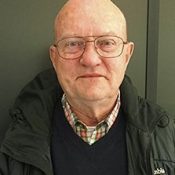
December 23, 2018 Ryukyu Shimpo
By Washington Special Correspondent Yukiyo Zaha
On December 19 former U.S. Army Colonel Lawrence Wilkerson, who worked as the chief of staff to U.S. Secretary of State Colin Powell during George W. Bush’s administration, had an interview with the Ryukyu Shimpo. In the early 1990s when Wilkerson served in leadership roles at the Marine Corps War College in Virginia, he analyzed investigations and research concerning the realignment and closure of U.S. bases that occurred after the Cold War. The results of his analyses revealed that a large portion of the stationing costs fell on the Japanese government, so that the expenses of maintaining the Marine Corps in Okinawa cost the U.S. 50 to 60 percent less than it would to maintain the Marine Corps in California. Wilkerson said that the whole analysis demonstrated that, “There was no genuine strategic need for those Marines on Okinawa. It was all about money and keeping them.”
It is unusual for a former high-level official of the U.S. military to declare that there is no strategic necessity for the Marine Corps being stationed on Okinawa.
Wilkerson is a key member of the Overseas Base Realignment and Closure Coalition (OBRACC), a group made up of U.S. intellectuals and former U.S. officials. OBRACC released a letter requesting the closure of U.S. military bases abroad, and addressed the letter to President Trump, Secretary of Defense Mattis, and Congress.
Concerning the Japanese government paying for Marine Corps stationing in Okinawa, Wilkerson said, “The costs on Okinawa were about 50-60 percent cheaper than the cost would be if those Marines were retained and kept in the United States, such as California. The Marines were looking at costs in California, principally.” This made it convenient for the U.S. in terms of public finance, and made it an economically poor choice for the U.S. to bring the Marines back to U.S. land. Because bases had also been closed in the United States, Marine Corps leaders were reluctant to close bases in Okinawa. Wilkerson explained that, “It was also looked at as bad to do by the Marine Corps leadership because they felt, in the spirit of the time, that if they brought those Marines home they would lose them. In other words, they would just cut them out. No more bodies. So, they were fearful of that.”
There is cause for concern that things such as climate change and natural disasters will cause financial losses on U.S. military facilities. As part of construction of the Futenma Replacement Facility in Henoko, Wilkerson says “it’s crazy” to build runways over the ocean at great expense.
The Japanese government insists that the Marine Corps presence in Henoko is for “deterrence.” In response Wilkerson points out, “There is a two-edged sword. On this side, yes. On the other side, making China re-arm, and making China spend more money on its military. Making China a more powerful, formidable enemy.”
Wilkerson explained that even if there were a conflict on the Korean peninsula, it would be unlikely that the Marines would be helpful. He said, “We used to say we’d probably get there after [the conflict] was over. Or if they did get there at all, they would simply be a minor addition to 600,000 Koreans. So, there was no real strategic reason.”
In addition, Wilkerson spoke about the U.S.-Japan Alliance and Japan’s defense. He explained, “It is a commitment to Japan and to the defense of Japan in public affairs terms, yes. That argument can be made. If you want to say that there is a strategic purpose for the presence on Okinawa, it’s the same strategic purpose for the presence in Yokosuka or anywhere else in Japan, like Misawa. It’s to convince the Japanese that we are indeed part of their security. The only really truly strategic asset in the Pacific for the United States of America, for our own national security interests, is Hawaii.”
(English translation by T&CT and Erin Jones)
Go to Japanese
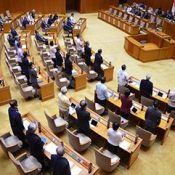
December 21, 2018 Ryukyu Shimpo
On December 20 the Okinawa Prefectural Assembly (chaired by Yonekichi Shinzato) held the final meeting of its November plenary session. At this meeting, the Assembly adopted a position statement through a majority vote, carried by the prefectural ruling coalition. The statement demands an immediate halt to the soil depositing operations being pushed through by the central government as part of new base construction in Henoko, Nago City. Part of the statement reads, “We absolutely cannot allow the negation of local government or violence to destroy our citizens’ self-governance,” in criticism of the central government’s position. It also demands that Futenma Air Station be immediately closed and demolished.
The position statement objects that the central government making use of the system of administrative appeal is “illegal and therefore void,” and claims that, “The prefectural government’s revocation of the land reclamation permit is valid, and therefore the construction is illegal.” In addition, the statement touches on Denny Tamaki’s victory in the Okinawa gubernatorial election by a margin of 80,000 votes, on the platform of opposition to Henoko base construction. The statement goes on to criticize that, “[The Japanese government] is ignoring Okinawans’ public opinion, hijacking legal procedure, and failing to listen to the just claims of the local government; acting as though forcing construction through is in line with domestic opinion.”
In the Prefectural Assembly the position statement was adopted through 12 supporting votes from the Social Democratic Party and Okinawa Social Mass Party coalition, 8 votes from the Okinawa Party, 6 votes from the Japanese Communist Party, and one independent vote. The opposition, the Okinawa branch of the Liberal Democratic Party, delivered 14 votes opposing the statement on the grounds that: “It is prudent to quickly remove the dangers associated with Futenma Air Station. Soil depositing was approved by the governor [Hirokazu Nakaima] on the basis of the Public Water Body Reclamation Act, and these operations are necessary to advance [Futenma’s closure].”
Komeito (4 members) and the Japan Innovation Party (2 members) were absent for the vote. Tsutomu Kinjo of Komeito said: “Our demand for relocation outside of Okinawa or outside of Japan has not changed, yet we are only seen as opposing [the new base]. It is time to explore new solutions.”
Morio Toma of the Innovation Party said, “By releasing a position statement we are hedging attempts to come to a solution. [The statement] doesn’t offer an alternate site. However, the forcing of soil deposits is deplorable.”
(English translation by T&CT and Erin Jones)
Go to Japanese
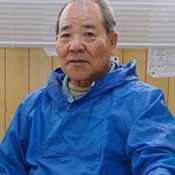
December 21, 2018 Ryukyu Shimpo
December 21 marked one week since soil deposits began at the planned land reclamation area in Oura Bay as part of the construction of the Futenma replacement facility in Henoko, Nago City. So, how do local Henoko citizens feel? Masao Nishikawa, 74 years old, has opposed the relocation plan for more than twenty years, ever since the relocation plan emerged. Director Tomoteru Tamari of the Henoko Chamber of Commerce, 59 years old, supports the plan as he hopes it will revitalize the city.
“Never give up,” says Masao Nishikawa
For more than 20 years, Nishikawa has expressed his intention to oppose the construction of a new base in Henoko. He insists that, “We must not say ‘We gave up.’”
On December 14 when the government forced through soil depositing work, he did not participate in the protest rally. He expressed his pain, “Every time I see news [reporting soil deposits] I feel pain in my chest. I could not join the heart-breaking rally.”
In 1997 when the relocation of USMC Futenma Air Station to Henoko was discussed, Nishikawa formed the Save Life Society with residents. The society appealed against the construction of the new base in Henoko Ward, yet was dissolved in 2015. Dissolution of the society was primarily due to the aging of the members. Nishikawa emphasized, “Not one among these residents gave up.”
Although Henoko Ward permits the construction of a new base conditionally, the Ministry of Defense finds difficulty in handling one of the conditions, specifically the separate compensation. Nishikawa says, “I want [the authorities] to take the opinions of residents into account with how they manage the ward.”
Twenty-two years have passed since the issue of new base construction emerged. Residents were divided into two camps on whether of not to accept the base. In regard to stopping new base construction, Nishikawa said, “I want [local authorities] to lead. We need to foster an environment where ward residents can take action.”
Tomoteru Tamari thinks compensation will brighten the town
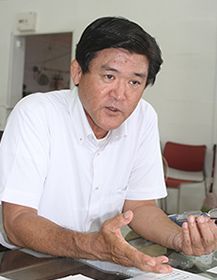
Tomoteru Tamari is a representative of the Henoko Research Institute and a director of the Henoko Chamber of Commerce
Tamari hopes to revitalize Henoko Ward and asks the state for “a firm response to the matter of compensation and its promotion measures.” His father ran Restaurant Washington in Henoko. He remembers a bustling city. After renovating the closed restaurant, he launched the Henoko Research Institute, which handles corporate invitation.
He has complex feelings about the disappearance of the offer of separate compensation, which was one of the ward’s conditions for accepting the base. Tamari said: “Residents will oppose [the base] if there will be no separate compensation. Nevertheless, the state has reduced the budget of the dissenting prefecture. Can one fight the giant in power? The base will surely come. It will be meaningless if there is nothing left for the ward after opposing construction.”
The soil deposits began without the discussion of compensation reaching a conclusion. Looking back over the past 20 years, Tamari said, “The Defense Bureau told the residents to expect something. What will it do for the ward?” He pointed out that compensation should be asked with a firm attitude, saying, “We have to negotiate with the state so that the compensation issue can be solved. We need them to think Henoko is a top priority.”
Tamari spoke persuasively, “I want Henoko to be a lively city. Even if the base comes, we need to do our best so that our children can live happily.”
(English translation by T&CT and Megumi Chibana)
Go to Japanese

December 18, 2018 Ryukyu Shimpo Digital Edition
At a little past 3:00 p.m. on December 18, the online petition to halt the new base construction in Henoko, Nago City in association with the relocation of the U.S. military Futenma Air Station surpassed its goal of 100,000 signatures and reached 100,343 signatures. People supporting the purpose of the petition used social media, such as Twitter and Facebook, to call out to others to sign the petition, which rapidly spread beyond the U.S. The plan is to collect even more signatures and appeal to the White House.

White House petition website to halt bringing in sediment for new base construction in Henoko, Nago City that reached 100,000 signature goal.
The petition was initiated on December 8 on the White House petition website, We the People, by 32-year-old and fourth-generation Okinawan-American Robert Kajiwara who lives in Hawaii.
Go to the White House petition website
Go to Japanese

December 24, 2018 Ryukyu Shimpo
By Yuri Shimizu
On December 25, it will have been once year since the reversion of the U.S. military’s Northern Training Area (NTA) land to landowners.
I took a walk through this land, led by Akino Miyagi, who researches insects in the area that once was Ada, Kunigami.
I can hear the chirps of birds, and butterflies flutter through the air. Stepping into this green forest, which has been incorporated into Yambaru National Park, deep in my bones I feel the sense of “return.”
At the same time however, as my eyes pass over un-fired bullets and used up flares from the U.S. military, the reality of a forest in pain is thrust before me.
In December of 2016, it was announced that 4,000 hectares of the NTA would be returned to Japan.
On the 16th of this month, I entered into the overgrown vegetation of the former training area from the side of the road.
After walking for about ten minutes along an animal trail with tree branches jutting out into it, suddenly I came upon the remains of a helipad used by the U.S. prior to the reversion.
On top of the gravel-covered remains of the helipad was a scattering of trash covered by a blue tarp.

Unused rounds found while walking through the forest. The eight in the front are 6.5 cm rounds, and the four in the back are 4.7 cm rounds
“Even after Japan came in to clean up, we still find a lot of un-fired bullets,” explains Miyagi.
Brushing aside leaves, I raked my fingers through the dirt and fell the smooth hard sensation of metal, and pulled some of these un-fired rounds from the ground.
In just over an hour, we were able to find 12 of these unused bullets.
The image of this reverted forest being free of ammunition now seems like a faraway thing.
There were also plastic wrappings from soldier rations, as well as concrete that appeared to be for industrial use.
We then climbed down from the top of the mountain to about halfway down.
As the “pyoi pyoi” warble of a Ryukyu robin, a Japanese-designated natural monument, echoes through the forest, a sword-tail newt endemic to the Ryukyus leaps out from the side of the trail.
Meanwhile, a Mycalesis madjicosa butterfly, another Ryukyu native, leisurely dances its way around a fir tree.

The Ryukyu-native sword-tail newt found along the trail
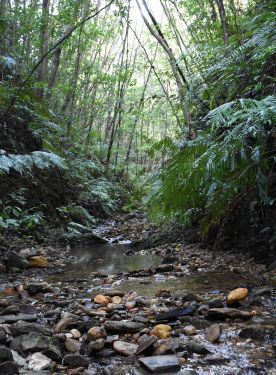
Water seeping from the ground to form a river. This unique area is home to countless native species
As we made our way down the mountain, the temperature began to rise, and water began to seep out from the ground.
It gradually became a waterway before forming a river. We walked along the clear steam, we came across the gray and rusted remains of a used flare dropped on the ground.
The sudden appearance of this refuse once again reminded us that this quiet forest was once a military training ground.
Deep in the mountains, we also discovered the remains of a pre-war kiln that was about three meters in diameter. “This area, where people used to live, has finally been returned to us. It had been taken by the U.S. military,” said Miyagi lively, before a frustrated expression appeared on his face.
The next day, December 17, I asked a police officer at the Ada Police station about the collection of the un-used ammunition.
“Has someone else found them too?” the officer asked as if it was something he was accustomed to.
He continued that the bullets should be given to the Okinawa Defense Bureau (ODB).
Miyagi claims that over the past year he has discovered over 250 bullets.

NTA reverted land and the Yanbaru National Park
“Kyo-ro-ro-ro-ro.” As the officer collected the bullet from me, and Okinawan Rail announced its existence with its song.
<Key Term> The U.S. Military’s Northern Training Area (NTA)
On December 22, 2016, the U.S. military announced that it would be returning 4,010 of the NTA’s total 7,513 hectares.
The cleanup of the area was carried out by Japan, not the U.S. military, and over a four month period the Okinawa Defense Bureau (ODB) engaged in a cleanup project over a 50,000 square meter area that included 10 disposal sites and decommissioned helipads.
Then, the land was officially returned to landowners on December 25, 2017.
In June of 2018, 3,700 hectares, or 90% of the reverted land, was incorporated into Yanbaru National Park.
There is now an effort afoot to have the area listed as a world natural heritage site in 2020.
(English translation by T&CT and Sam Grieb)
Go to Japanese

December 20, 2018 Ryukyu Shimpo Digital Edition
Nago – Having received confirmation that the stray bullet discovered in the Sukuta ward of Nago in June had in fact come from the U.S. military, Sukuta Ward Chief Mikikazu Higa met with the Okinawa Defense Bureau (ODB) December 20 at the Sukuta Community Center to officially request that measure be taken to prevent such an incident from reoccurring.
Higa said while handing over his written statement, “We request that Camp Schwab’s Practice Range 10 not be reopened for live-fire exercises.”
ODB planning department head Shinya Ito said as an interim report, “Burdening [residents] with this kind of uneasiness is inexcusable. While the cause of the incident is still being investigated, we will ensure that the U.S. military takes preventative measures, and will then provide another report.”
(English translation by T&CT and Sam Grieb)
Go to Japanese

December 18, 2018 Ryukyu Shimpo
Okinawa Urban Monorail suspended its service temporarily while an unexploded ordnance was diffused in Uebaru, Naha City during the morning hours on Dec.
16th. At each station, signs were posted near the turnstiles to notify passengers of the service disruption and attendants were busy explaining the situation to customers.
The shutdown largely affected those who were out and about on Sunday: Local customers and tourists unaware of the service suspension seemed confounded and were forced to take a bus or taxi instead, while some opted to walk or bike to their destinations.
Hapu Yamane, a student at Naha City’s Kinjo Junior High School, arrived Oroku station round 9:40 that morning.
The eighth-grader had planned to meet a friend at Asato station, but due to the service suspension, had no other choice but to go home and, “ask my mom to drive me instead.” The frustrated 14-year-old also said of the unexploded ordnance, “it’s scary to think that it’s so close by.”
Iraha Junior High School student Ryo Ooshiro, biked from Tomigusuku City to Oroku station with two friends and planned on taking the monorail to Omoromachi station.
“I had no idea an unexploded bomb was found or that the monorail service was shutdown.”
The 15-year-old decided to bike to Omoromachi instead.
Ryoma Hoshi, 34, and Mariko Yamashina, 35, were visiting from Tokyo.
They were able to catch a monorail headed to Naha airport at around 9:20 a.m., just before service was cut off. Hoshi said that finding an unexploded ordnance is “unthinkable in Tokyo.”
Yamashina was also surprised, and said she “realized the legacy of war still lingers.”
It was just a while ago on Dec. 9th that another unexploded ordnance was diffused in a residential area of Uebaru.
According to the local residents, the site used to be a hospital.
Kiyoki Toyama, who has lived in the area for 60 years, seemed uneasy.
“It’s terrifying to think, what if the bomb had gone unnoticed during construction and exploded?” he said, as he evacuated. “I can’t believe that 73 years after the war, we still have unexploded bombs nearby.”
(English translation by T&CT and Monica Shingaki)
Go to Japanese

December 15, 2018 Ryukyu Shimpo
“What can be said about a country that is able to show such contempt toward public opinion? The very nature of the country of Japan is being called into question.”
On December 14, Mikiko Onaga, 63, wife of former governor Takeshi Onaga, who passed away in August, visited the gate to Camp Schwab in Henoko, Nago City and expressed indignation at the government barging forward with dumping soil for land reclamation.
Onaga says she hesitated to make the trip to Henoko at a time when Governor Denny Tamaki is working to prevent the base construction.
“I feel bad about bringing the Onaga name to the fore when Denny is working so hard,” she said, and admitted that she had not intended to make the trip until the last minute.
Yet she read a letter from a reader in the newspaper calling on people to participate in the protest for the sake of future children and, after much vacillation, she decided to go.
“If I didn’t come today, I would have regretted it for the rest of my life,” she said.
As an Okinawan, she says she feels strong anger toward the government and, at the same time, questions the indifference mainland Japanese seem to have toward Okinawa’s base issues.
“Just as my husband intended to be a father to all Okinawans, the government must be a parent to all Japanese citizens. How can they slight us so?”
she questioned angrily, and responded to a reporter’s question with a question of her own–“Don’t you think there’s something wrong with the way popular will is ignored in Okinawa alone?”
“I think my husband is here with us today.
He always said, ‘The final battlefield to stop [the base construction] is the front lines of the protest site.’ The people’s spirit cannot be broken. Okinawans have the strength to rise back up again even when we are down,” she stated resolutely.
(English translation by T&CT and Sandi Aritza)
Go to Japanese
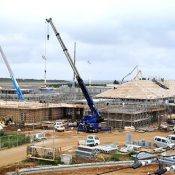
December 16, 2018 Ryukyu Shimpo
The Shimojishima Airport Management Co., Ltd. (SAMCO, Kentaro Tomono, Representative Director) in Miyakojima, which is set to open a passenger terminal at Shimojishima Airport on March 30, 2019, is working with around ten airlines to establish new routes, both domestic and international.
The expansion of routes is expected to lead directly to a massive influx of tourists to the island, and a daily flight from a low-cost carrier (LCC) is expected to lead to about 3.8 billion yen annually in tourist spending.
Additional routes should multiply this economic benefit, so the company is working to establish new routes.
The terminal will be managed by Mitsubishi Estate, who began construction in October of 2017.
In January of 2018, Mitsubishi Estate established SAMCO in a joint investment with Kokuba-Gumi and Sojitz.
In October of this year, the LCC Jetstar Japan established the maiden route for the airport between Narita and Shimojishima.
Currently, no other routes have been officially established, however SAMCO is working with around 10 different airlines to establish domestic routes from Chubu, Kansai, and Kyushu, and international routes from places such as Taiwan, Hong Kong, Seoul, and Shanghai.
The additional routes will lead to an influx of tourists to the island, providing a significant economic boost.
SAMCO estimates that a single route making once-daily flights will lead to about 3.8 billion yen annually in tourist spending.
This was calculated as a single flight having a maximum capacity of about 180 passengers, with an average capacity of 75% for 135 passengers daily.
As 90% of these passengers are expected to be tourists, it is calculated that a single tourist will spend on average 86,554 yen (about $770 USD) in the Miyako region.
By increasing these flights, the total tourist spend could double or even triple, so the expectation is that new routes will be established.
SAMCO is continuing to negotiate routes with a goal of having multiple domestic round-trip flights, international charter flights, and regular international service in the summer in 2019, with the hope of achieving their original 2021 goal of bringing 300,000 tourists to the island each year by 2020.
Meanwhile, the construction of airport facilities will bear features geared specifically towards tourists.
The airport will be comprised of multiple buildings, and will have as few walls as possible, and have a design reminiscent of a spacious villa.
The finished product is set to resemble Samui Airport in Thailand.
The airport will come equipped with amenities such as a car rental and return area, convenient for tourists.
Combined with Miyako Island’s lush nature and ocean, the unique facility is sure to attract tourists from all over.
(English translation by T&CT and Sam Grieb)
Go to Japanese
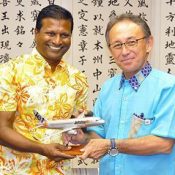
December 5, 2018 Ryukyu Shimpo
On November 29, Jetstar Asia Airways CEO Barathan Pasupathi visited Governor Denny Tamaki at the prefectural office.
Pasupathi expressed his gratitude for service between Naha and Singapore doing well.
This service route has entered its second year since establishment.
He said, “Okinawa is magical.
It’s full of allure and diversity as a tourist spot.”
Pasupathi also voiced his opinion to utilize Jetstar’s network to extend service routes to tourists from Indonesia, Malaysia, and Australia.
The said service route is the only direct flight that connects Naha Airport and Singapore Changi Airport.
Service began last November and in the first year, more than 33,000 people used it.
In response to entering its second year since going into service, the number of roundtrip flights increased from three to four times a week starting November 15.
(English translation by T&CT and Chelsea Ashimine)
Go to Japanese

















 Webcam(Kokusai Street)
Webcam(Kokusai Street)


